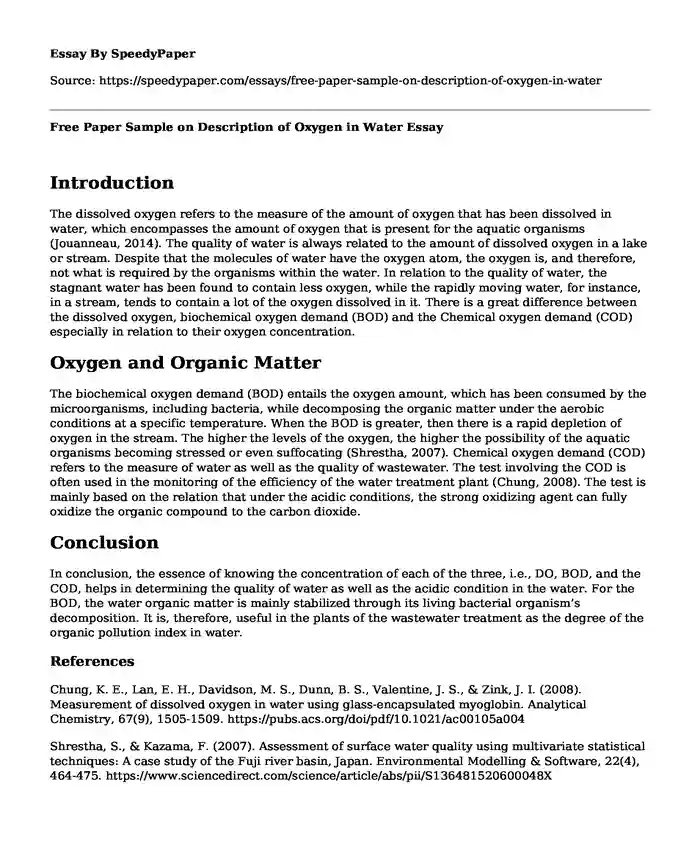Introduction
The dissolved oxygen refers to the measure of the amount of oxygen that has been dissolved in water, which encompasses the amount of oxygen that is present for the aquatic organisms (Jouanneau, 2014). The quality of water is always related to the amount of dissolved oxygen in a lake or stream. Despite that the molecules of water have the oxygen atom, the oxygen is, and therefore, not what is required by the organisms within the water. In relation to the quality of water, the stagnant water has been found to contain less oxygen, while the rapidly moving water, for instance, in a stream, tends to contain a lot of the oxygen dissolved in it. There is a great difference between the dissolved oxygen, biochemical oxygen demand (BOD) and the Chemical oxygen demand (COD) especially in relation to their oxygen concentration.
Oxygen and Organic Matter
The biochemical oxygen demand (BOD) entails the oxygen amount, which has been consumed by the microorganisms, including bacteria, while decomposing the organic matter under the aerobic conditions at a specific temperature. When the BOD is greater, then there is a rapid depletion of oxygen in the stream. The higher the levels of the oxygen, the higher the possibility of the aquatic organisms becoming stressed or even suffocating (Shrestha, 2007). Chemical oxygen demand (COD) refers to the measure of water as well as the quality of wastewater. The test involving the COD is often used in the monitoring of the efficiency of the water treatment plant (Chung, 2008). The test is mainly based on the relation that under the acidic conditions, the strong oxidizing agent can fully oxidize the organic compound to the carbon dioxide.
Conclusion
In conclusion, the essence of knowing the concentration of each of the three, i.e., DO, BOD, and the COD, helps in determining the quality of water as well as the acidic condition in the water. For the BOD, the water organic matter is mainly stabilized through its living bacterial organism’s decomposition. It is, therefore, useful in the plants of the wastewater treatment as the degree of the organic pollution index in water.
References
Chung, K. E., Lan, E. H., Davidson, M. S., Dunn, B. S., Valentine, J. S., & Zink, J. I. (2008). Measurement of dissolved oxygen in water using glass-encapsulated myoglobin. Analytical Chemistry, 67(9), 1505-1509. https://pubs.acs.org/doi/pdf/10.1021/ac00105a004
Shrestha, S., & Kazama, F. (2007). Assessment of surface water quality using multivariate statistical techniques: A case study of the Fuji river basin, Japan. Environmental Modelling & Software, 22(4), 464-475. https://www.sciencedirect.com/science/article/abs/pii/S136481520600048X
Jouanneau, S., Resources, L., Durand, M. J., Boukabache, A., Picot, V., Primault, Y., ... & Thouand, G. (2014). Methods for assessing biochemical oxygen demand (BOD): A review. Water Research.
https://www.usgs.gov/special-topic/water-science-school/science/biological-oxygen-demand-bod-and-water?qt-science_center_objects=0#qt-science_center_objects
Cite this page
Free Paper Sample on Description of Oxygen in Water. (2023, Oct 17). Retrieved from https://speedypaper.com/essays/free-paper-sample-on-description-of-oxygen-in-water
Request Removal
If you are the original author of this essay and no longer wish to have it published on the SpeedyPaper website, please click below to request its removal:
- Pilot Shortage Essay Sample
- Free Essay on Isaac Newton's Biography and Discoveries
- Why Can't Everyone Have a Home? Article Review Essay Sample
- Article Analysis Essay: ERPs Reveal Differences In Syntactic Processing
- Essay Sample on Use of Math in Money Management
- Essay Sample on Fredrick Douglass and Hamlet Comparison Essay
- Free Paper Example on Cholesterol
Popular categories





